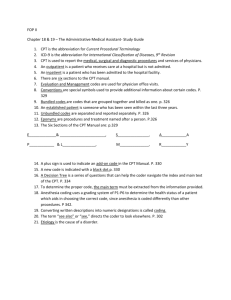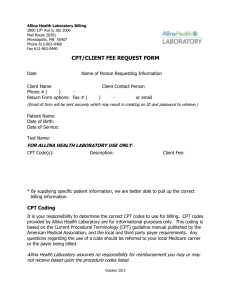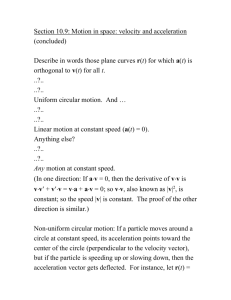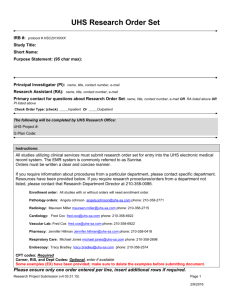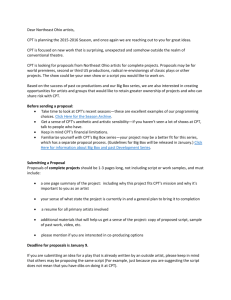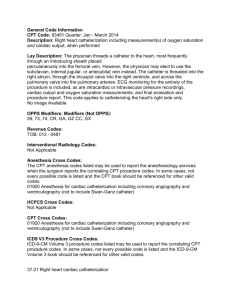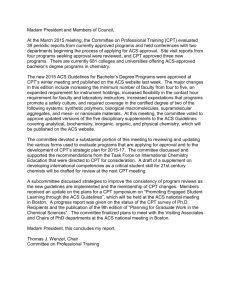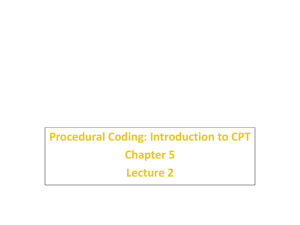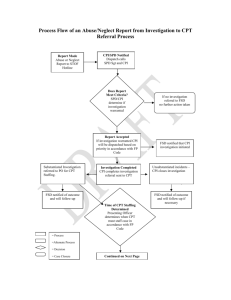MATH /stat 304 Solutions: QUIZ V
advertisement
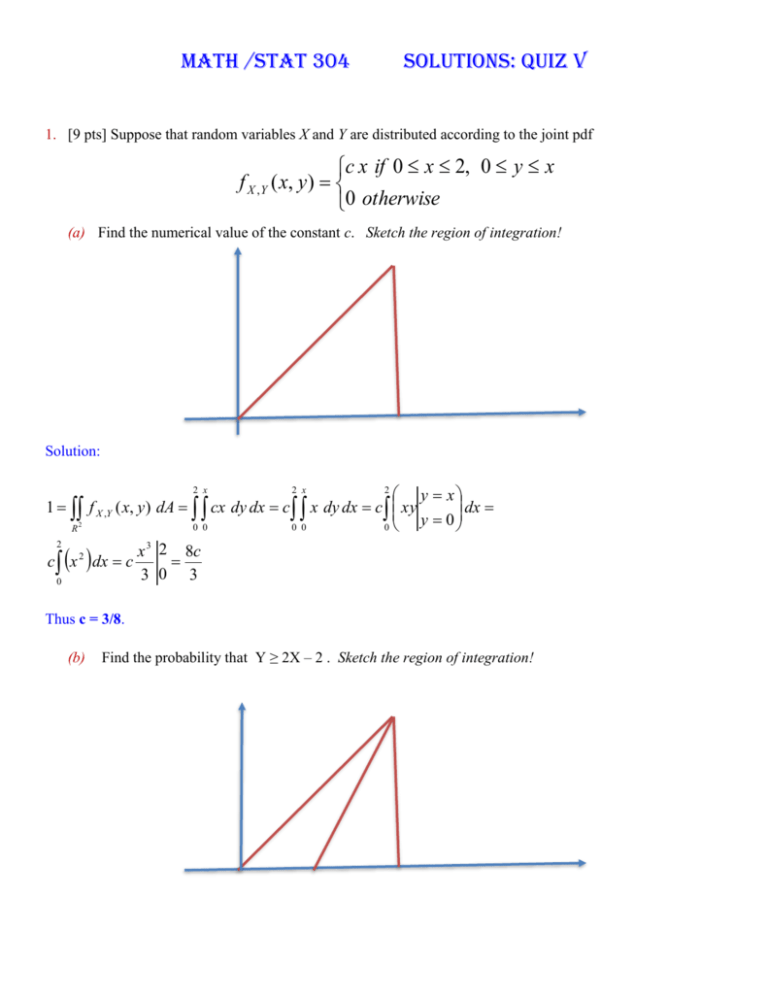
MATH /stat 304
Solutions: QUIZ V
1. [9 pts] Suppose that random variables X and Y are distributed according to the joint pdf
c x if 0 x 2, 0 y x
f X , Y ( x, y )
0 otherwise
(a) Find the numerical value of the constant c. Sketch the region of integration!
Solution:
y x
dx
1 f X ,Y ( x, y ) dA cx dy dx c x dy dx c xy
y
0
0 0
0 0
0
R2
2
x 3 2 8c
2
c x dx c
3 0 3
0
2 x
2 x
2
Thus c = 3/8.
(b)
Find the probability that Y ≥ 2X – 2 . Sketch the region of integration!
P(Y 2 X 2)
2
2 1 y / 2
f
X ,Y
{ y 2 x 2}
( x, y ) dA
0
2
x2 1 y / 2
y (3 / 8) x dx dy (3 / 8)0 2 x y dy
2
(3 / 16) (1 y / 2) y dy (3 / 16) (1 y 3 y 2 / 4 dy
2
2
0
0
(3 / 16) y y 2 / 2 y 3 / 4
02 (3 / 16) 2 2 2 3 / 8
(c) Find the conditional expectation of Y given that X = 1/3.
Solution: Begin by finding the marginal pdf of X evaluated at x = 1/3.
x
f X ( x) (3 / 8) x dy (3 / 8) xy
0
x
(3 / 8) x 2
y0
So f X (1 / 3) (3 / 8)(1 / 3) 2 1 / 24
Hence
1/ 3
E (Y | X 1 / 3)
yf
0
1/ 3
0
y
1/ 3
Y|X
( y | 1 / 3) dy
y
0
f X ,Y (1 / 3, y )
f X (1 / 3)
1/ 3
(3 / 8)(1 / 3)
dy 3 ( y 2 / 2)
3(1 / 9)(1 / 2) 1 / 6
0
1 / 24
dy
2. [6 pts] Flip a three-sided fair die three times. Let X = 0 if the three numbers on the die are strictly
increasing; let X = -1 if the numbers are strictly decreasing; let X = 13 otherwise. Write the MGF of X.
Solution: The sample space consists of 27 equiprobable outcomes. Now X = 0 if only if the outcome is
(1, 2, 3) and X = -1 if and only if the outcome is (3, 2, 1). Thus P(X = 13) = 25/27. Thus the MGF of X is
given by:
M(t) = E(etX) = (1/27)e0t + (1/27)e-1t + (25/27)e13t = 1/27 + (1/27)e-t + (25/27)e13t
3. [6 pts] Given a random variable X with pdf
x if 0 x 1
f X ( x) 2 x if 1 x 2
0 otherwise
Find the MGF of X. Simplify.
Solution:
M (t ) E (e tX )
2
1
2
0
0
1
tx
tx
tx
tx
e f X ( x)dx e f X ( x)dx e f X ( x)dx e f X ( x)dx
1
2
1
2
2
0
1
0
1
1
tx
tx
tx
tx
tx
e x dx e (2 x) dx e x dx 2 e dx e x dx
2 tx 2 e tx
1
2
e tx
e
2 (tx 1)
(
tx
1
)
2
x 0 t
x 1 t
x 1
t
1 t
2
1
e (t 1) (1) e 2t e t 2 e 2t (2t 1) e t (t 1)
2
t
t
t
(e t 1) 2
t2
4. [6 pts] Find the variance of the random variable Y if MY(t) = e2t/(1 – t2).
Solution: E(X) = M’(0) and E(X2) = M’’(0)
M(t) = e2t (1 – t2)-1
M’(t) = e2t 2 t (1 – t2)-2 + 2 e2t (1 – t2)-1 = 2 e2t (1 – t2)-2 (t + (1 – t2)) = 2 e2t (1 – t2)-2 (t + 1 – t2)
M’(0) = 2
M’’(t) = 2 e2t (1 – t2)-2 d/dt (t + 1 – t2) + 2(1 – t2)-2 (t + 1 – t2) d/d(e2t) + 2e2t (t + 1 – t2) d/dt((1 – t2)-2) =
2e2t (1 – t2)-2 (1 – 2t) + 2(1 – t2)-2 (t + 1 – t2) 2(e2t) + 2 e2t (t + 1 – t2) (-2)(1 – t2)-3 (-2t)
M’’(t) = 2 + 4 + 0 = 6
Thus var(X) =M’’(0) – (M’(0))2 = 6 – 22 = 2
Shortcut: Using a Maclaurin series:
MY(t) = e2t/(1 – t2) = e2t (1 + t2 + t4 + …) = (1 + 2t + (2t)2/2! + (2t)3/3! + …) (1 + t2 + t4 + …) =
1 + 2t + (1 + 2) t2 + …
Hence M’(0) = 2 and M’’(0) = 6
Extra Credit:
The joint pdf of X and Y is given by
ex / ye y
for 0 x , 0 y
y
f X , Y ( x, y )
0 otherwise
Compute E(X|Y=y]
Solution:
First find the marginal pdf of Y, fY(y), for y>0.
f Y ( y)
0
0
f X ,Y ( x, y) dx f X ,Y ( x, y) dx
ex / y e y
dx e x / y e y
ey
x0
y
e y if y 0
In other words, f Y ( y)
0 otherwise
Now, for y>0, and x>0
ex / ye y
f X , Y ( x, y )
ex / y
y
f X |Y ( x | y )
fY ( y)
y
ey
In other words, for fixed y>0,
ex / y
for x 0
f X |Y ( x | y ) y
0 otherwise
Hence
xe x / y
1
E ( X | Y y ) x f X |Y ( x | y ) dx
dx xe x / y dx
y
y0
0
0
1
y
ex / y
(
x
1
)
y
2
x
0
1
/
y
“I think you're begging the question,'' said Haydock, “and I can see looming ahead one of those terrible
exercises in probability where six men have white hats and six men have black hats and you have to work it out
by mathematics how likely it is that the hats will get mixed up and in what proportion. If you start thinking
about things like that, you would go round the bend. Let me assure you of that!''
- Agatha Christie, The Mirror Crack'd

